2017 PEUGEOT 4008 tow
[x] Cancel search: towPage 130 of 368
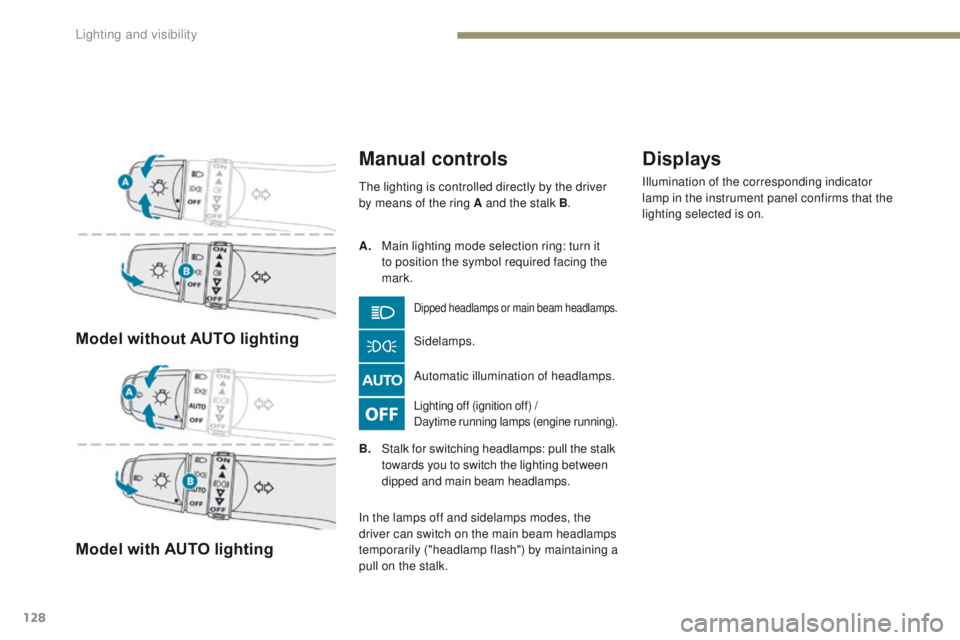
128
4008_en_Chap05_Eclairage-et-visibilite_ed01-2016
Model without AUTO lighting
Model with AUTO lighting
Manual controls
Lighting off (ignition off) /
Daytime running lamps (engine running).
Automatic illumination of headlamps. Sidelamps.
Dipped headlamps or main beam headlamps.
Displays
Illumination of the corresponding indicator
lamp in the instrument panel confirms that the
lighting selected is on.
A.
M
ain lighting mode selection ring: turn it
to position the symbol required facing the
mark.th
e lighting is controlled directly by the driver
by means of the ring A and the stalk B .
B.
S
talk for switching headlamps: pull the stalk
towards you to switch the lighting between
dipped and main beam headlamps.
In the lamps off and sidelamps modes, the
driver can switch on the main beam headlamps
temporarily ("headlamp flash") by maintaining a
pull on the stalk.
Lighting and visibility
Page 137 of 368
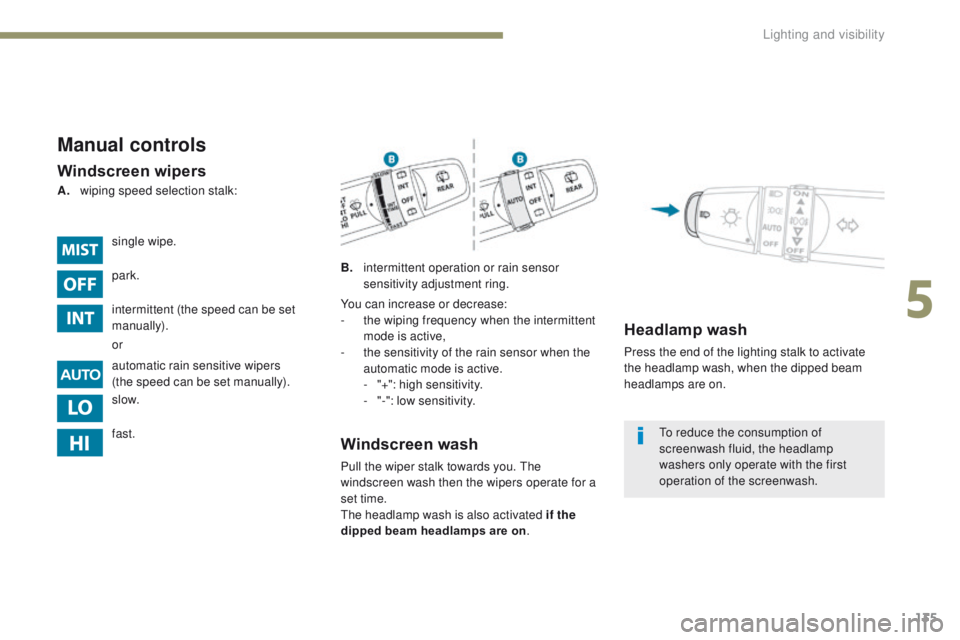
135
4008_en_Chap05_Eclairage-et-visibilite_ed01-2016
Manual controls
Windscreen wipers
B. intermittent operation or rain sensor
sensitivity adjustment ring.
Windscreen wash
Pull the wiper stalk towards you. th e
windscreen wash then the wipers operate for a
set time.
th
e headlamp wash is also activated if the
dipped beam headlamps are on .
Headlamp wash
Press the end of the lighting stalk to activate
the headlamp wash, when the dipped beam
headlamps are on.
single wipe.
park.
intermittent (the speed can be set
manually).
or
automatic rain sensitive wipers
(the speed can be set manually).
slow.
fast.
A.
w
iping speed selection stalk:
You can increase or decrease:
-
t
he wiping frequency when the intermittent
mode is active,
- t
he sensitivity of the rain sensor when the
automatic mode is active.
-
"
+": high sensitivity.
-
"
-": low sensitivity.
to r
educe the consumption of
screenwash fluid, the headlamp
washers only operate with the first
operation of the screenwash.
5
Lighting and visibility
Page 144 of 368
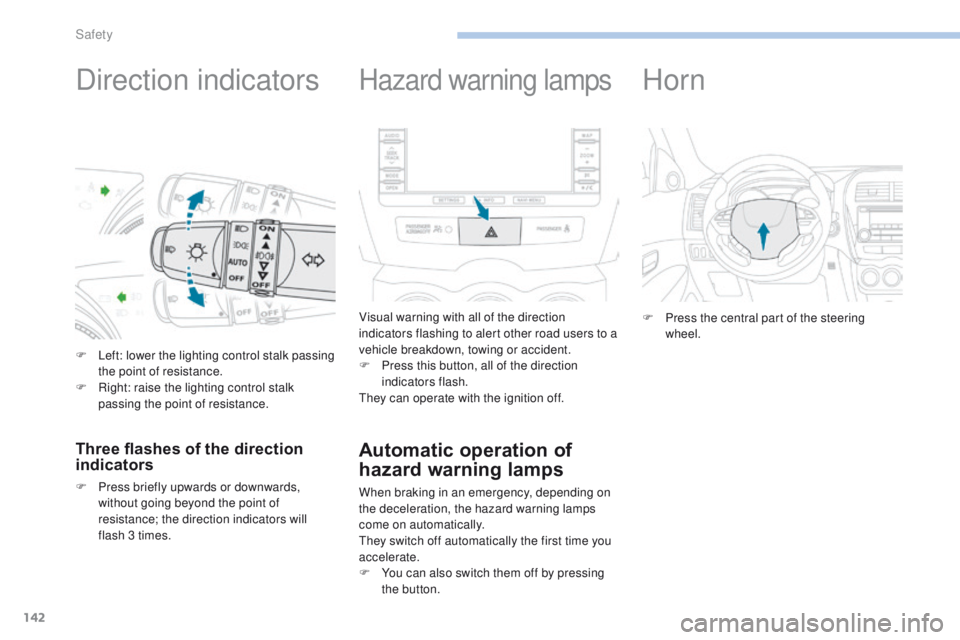
142
4008_en_Chap06_securite_ed01-2016
Direction indicators
F Left: lower the lighting control stalk passing the point of resistance.
F
R
ight: raise the lighting control stalk
passing the point of resistance.
Three flashes of the direction
indicators
F Press briefly upwards or downwards, without going beyond the point of
resistance; the direction indicators will
flash 3 times.
Hazard warning lamps
Visual warning with all of the direction
indicators flashing to alert other road users to a
vehicle breakdown, towing or accident.
F
P
ress this button, all of the direction
indicators flash.
th
ey can operate with the ignition off.
Automatic operation of
hazard warning lamps
When braking in an emergency, depending on
the deceleration, the hazard warning lamps
come on automatically.
th
ey switch off automatically the first time you
accelerate.
F
Y
ou can also switch them off by pressing
the button.
Horn
F Press the central part of the steering wheel.
Safety
Page 151 of 368
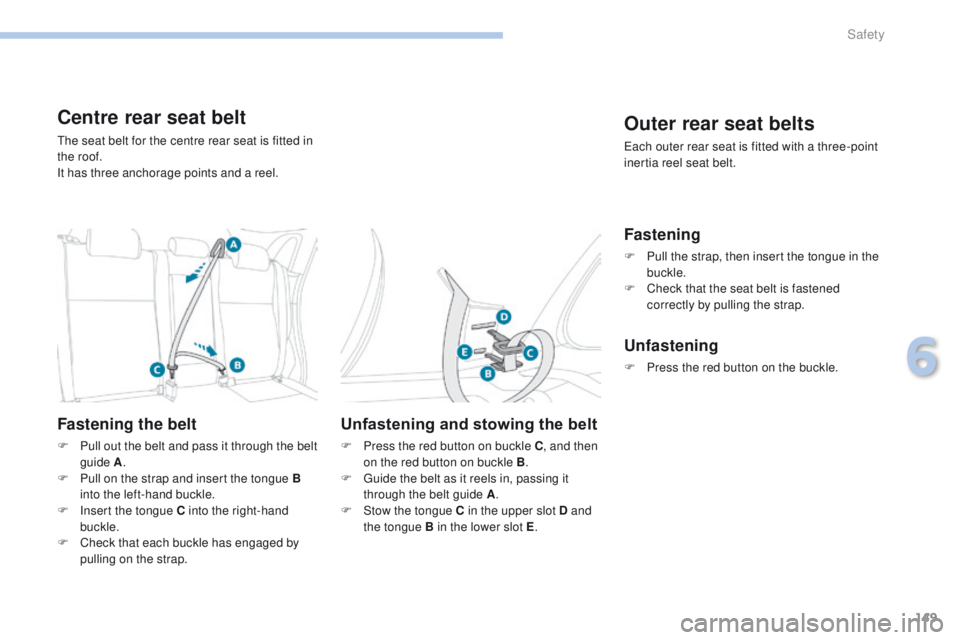
149
4008_en_Chap06_securite_ed01-2016
Centre rear seat belt
the seat belt for the centre rear seat is fitted in
the roof.
It has three anchorage points and a reel.
Fastening the belt
F Pull out the belt and pass it through the belt guide A .
F
P
ull on the strap and insert the tongue B
into the left-hand buckle.
F
I
nsert the tongue C into the right-hand
buckle.
F
C
heck that each buckle has engaged by
pulling on the strap.
Unfastening and stowing the belt
F Press the red button on buckle C , and then
on the red button on buckle B .
F
g
u
ide the belt as it reels in, passing it
through the belt guide A .
F
S
tow the tongue C in the upper slot D and
the tongue B in the lower slot E .
Outer rear seat belts
each outer rear seat is fitted with a three-point
inertia reel seat belt.
Fastening
F Pull the strap, then insert the tongue in the
buckle.
F
C
heck that the seat belt is fastened
correctly by pulling the strap.
Unfastening
F Press the red button on the buckle.
6
Safety
Page 152 of 368
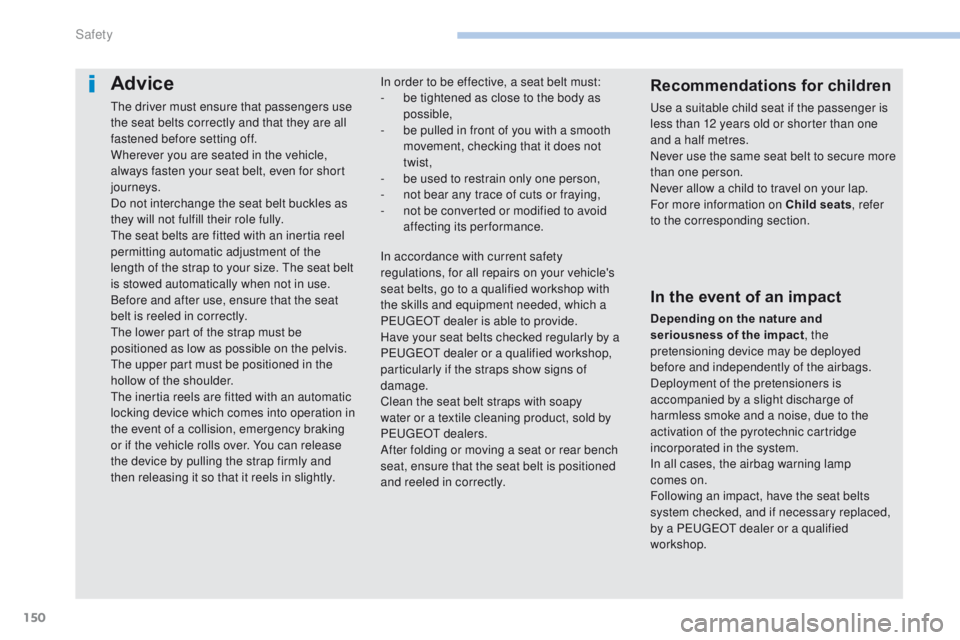
150
4008_en_Chap06_securite_ed01-2016
Advice
the driver must ensure that passengers use
the seat belts correctly and that they are all
fastened before setting off.
Wherever you are seated in the vehicle,
always fasten your seat belt, even for short
journeys.
Do not interchange the seat belt buckles as
they will not fulfill their role fully.
th
e seat belts are fitted with an inertia reel
permitting automatic adjustment of the
length of the strap to your size.
t
h
e seat belt
is stowed automatically when not in use.
Before and after use, ensure that the seat
belt is reeled in correctly.
th
e lower part of the strap must be
positioned as low as possible on the pelvis.
th
e upper part must be positioned in the
hollow of the shoulder.
th
e inertia reels are fitted with an automatic
locking device which comes into operation in
the event of a collision, emergency braking
or if the vehicle rolls over. You can release
the device by pulling the strap firmly and
then releasing it so that it reels in slightly.
Recommendations for children
use a suitable child seat if the passenger is
less than 12 years old or shorter than one
and a half metres.
Never use the same seat belt to secure more
than one person.
Never allow a child to travel on your lap.
For more information on Child seats , refer
to the corresponding section.
In order to be effective, a seat belt must:
-
b
e tightened as close to the body as
possible,
-
b
e pulled in front of you with a smooth
movement, checking that it does not
twist,
-
b
e used to restrain only one person,
-
n
ot bear any trace of cuts or fraying,
-
n
ot be converted or modified to avoid
affecting its performance.
In the event of an impact
Depending on the nature and
seriousness of the impact , the
pretensioning device may be deployed
before and independently of the airbags.
Deployment of the pretensioners is
accompanied by a slight discharge of
harmless smoke and a noise, due to the
activation of the pyrotechnic cartridge
incorporated in the system.
In all cases, the airbag warning lamp
comes
on.
Following an impact, have the seat belts
system checked, and if necessary replaced,
by a P
e
uge
Ot
dealer or a qualified
workshop.
In accordance with current safety
regulations, for all repairs on your vehicle's
seat belts, go to a qualified workshop with
the skills and equipment needed, which a
Pe
ugeOt d
ealer is able to provide.
Have your seat belts checked regularly by a
P
e
uge
Ot
dealer or a qualified workshop,
particularly if the straps show signs of
damage.
Clean the seat belt straps with soapy
water or a textile cleaning product, sold by
P
e
uge
Ot d
ealers.
After folding or moving a seat or rear bench
seat, ensure that the seat belt is positioned
and reeled in correctly.
Safety
Page 153 of 368
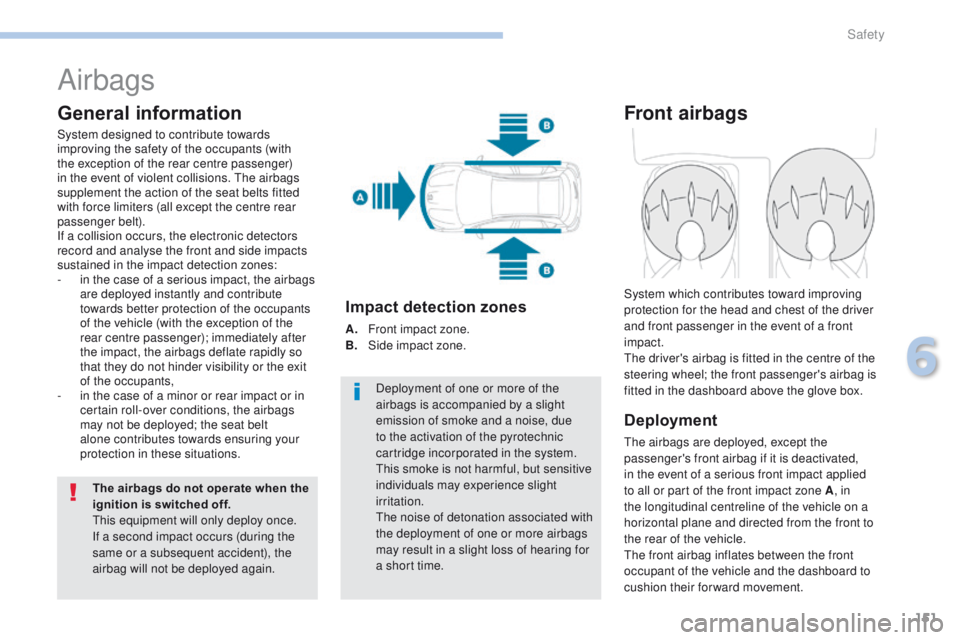
151
4008_en_Chap06_securite_ed01-2016
Airbags
General information
System designed to contribute towards
improving the safety of the occupants (with
the exception of the rear centre passenger)
in the event of violent collisions. t
h
e airbags
supplement the action of the seat belts fitted
with force limiters (all except the centre rear
passenger belt).
If a collision occurs, the electronic detectors
record and analyse the front and side impacts
sustained in the impact detection zones:
-
i
n the case of a serious impact, the airbags
are deployed instantly and contribute
towards better protection of the occupants
of the vehicle (with the exception of the
rear centre passenger); immediately after
the impact, the airbags deflate rapidly so
that they do not hinder visibility or the exit
of the occupants,
-
i
n the case of a minor or rear impact or in
certain roll-over conditions, the airbags
may not be deployed; the seat belt
alone contributes towards ensuring your
protection in these situations.
The airbags do not operate when the
ignition is switched off.
th
is equipment will only deploy once.
If a second impact occurs (during the
same or a subsequent accident), the
airbag will not be deployed again. Deployment of one or more of the
airbags is accompanied by a slight
emission of smoke and a noise, due
to the activation of the pyrotechnic
cartridge incorporated in the system.
th
is smoke is not harmful, but sensitive
individuals may experience slight
irritation.
th
e noise of detonation associated with
the deployment of one or more airbags
may result in a slight loss of hearing for
a short time.
Impact detection zones
A. Front impact zone.
B. S ide impact zone.
Front airbags
Deployment
the airbags are deployed, except the
passenger's front airbag if it is deactivated,
in the event of a serious front impact applied
to all or part of the front impact zone A , in
the longitudinal centreline of the vehicle on a
horizontal plane and directed from the front to
the rear of the vehicle.
th
e front airbag inflates between the front
occupant of the vehicle and the dashboard to
cushion their forward movement. System which contributes toward improving
protection for the head and chest of the driver
and front passenger in the event of a front
impact.
th
e driver's airbag is fitted in the centre of the
steering wheel; the front passenger's airbag is
fitted in the dashboard above the glove box.
6
Safety
Page 155 of 368
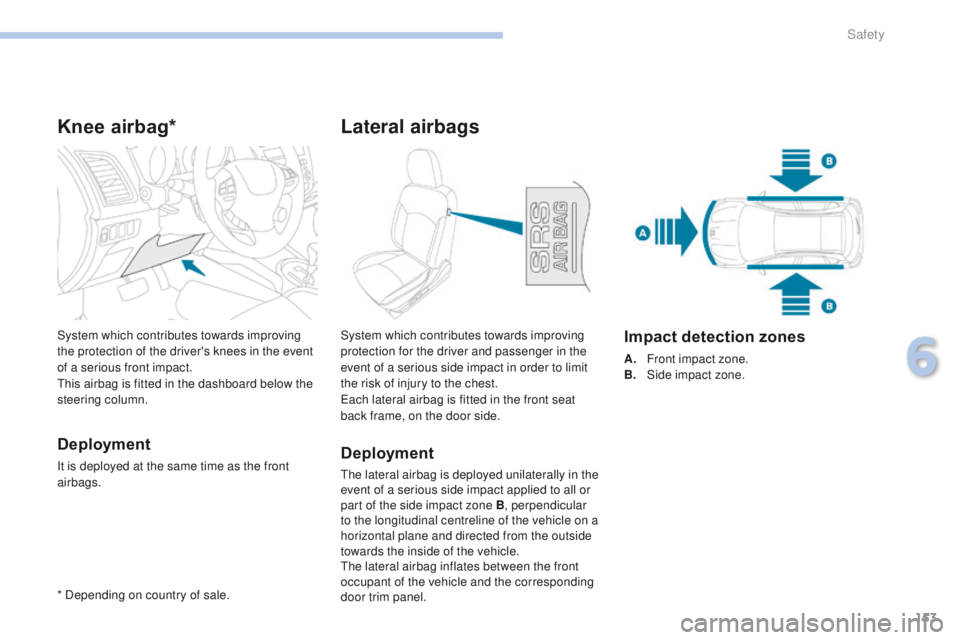
153
4008_en_Chap06_securite_ed01-2016
Knee airbag*
Deployment
It is deployed at the same time as the front
airbags. System which contributes towards improving
the protection of the driver's knees in the event
of a serious front impact.
th
is airbag is fitted in the dashboard below the
steering column. System which contributes towards improving
protection for the driver and passenger in the
event of a serious side impact in order to limit
the risk of injury to the chest.
ea
ch lateral airbag is fitted in the front seat
back frame, on the door side.Deployment
the lateral airbag is deployed unilaterally in the
event of a serious side impact applied to all or
part of the side impact zone B, perpendicular
to the longitudinal centreline of the vehicle on a
horizontal plane and directed from the outside
towards the inside of the vehicle.
th
e lateral airbag inflates between the front
occupant of the vehicle and the corresponding
door trim panel.
Impact detection zones
A. Front impact zone.
B. S
ide impact zone.
* Depending on country of sale.
Lateral airbags
6
Safety
Page 156 of 368
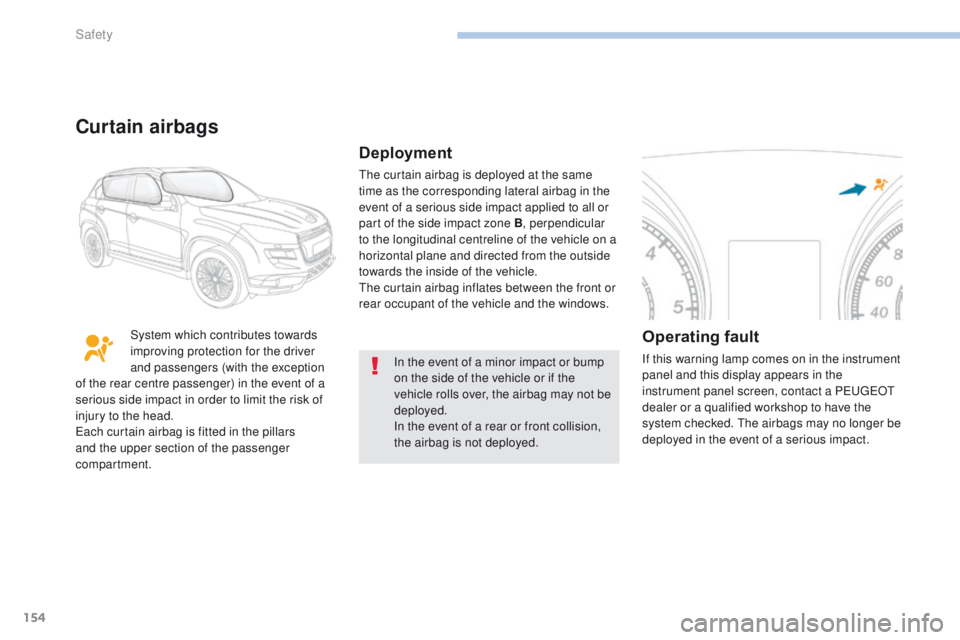
154
4008_en_Chap06_securite_ed01-2016
In the event of a minor impact or bump
on the side of the vehicle or if the
vehicle rolls over, the airbag may not be
deployed.
In the event of a rear or front collision,
the airbag is not deployed.
System which contributes towards
improving protection for the driver
and passengers (with the exception
of the rear centre passenger) in the event of a
serious side impact in order to limit the risk of
injury to the head.
ea
ch curtain airbag is fitted in the pillars
and the upper section of the passenger
compartment.
Curtain airbags
Deployment
the curtain airbag is deployed at the same
time as the corresponding lateral airbag in the
event of a serious side impact applied to all or
part of the side impact zone B, perpendicular
to the longitudinal centreline of the vehicle on a
horizontal plane and directed from the outside
towards the inside of the vehicle.
th
e curtain airbag inflates between the front or
rear occupant of the vehicle and the windows.
Operating fault
If this warning lamp comes on in the instrument
panel and this display appears in the
instrument panel screen, contact a P
e
uge
Ot
dealer or a qualified workshop to have the
system checked.
t
h
e airbags may no longer be
deployed in the event of a serious impact.
Safety